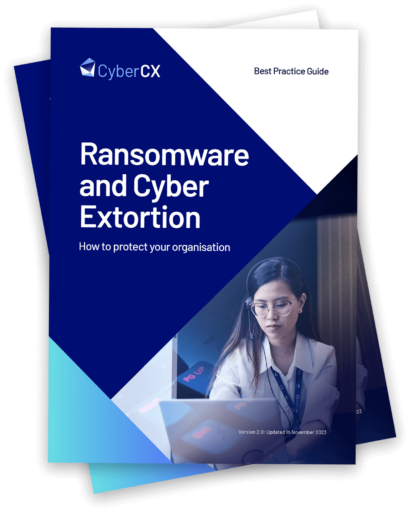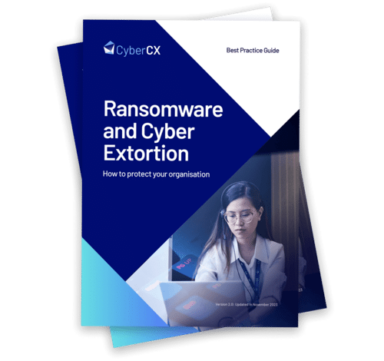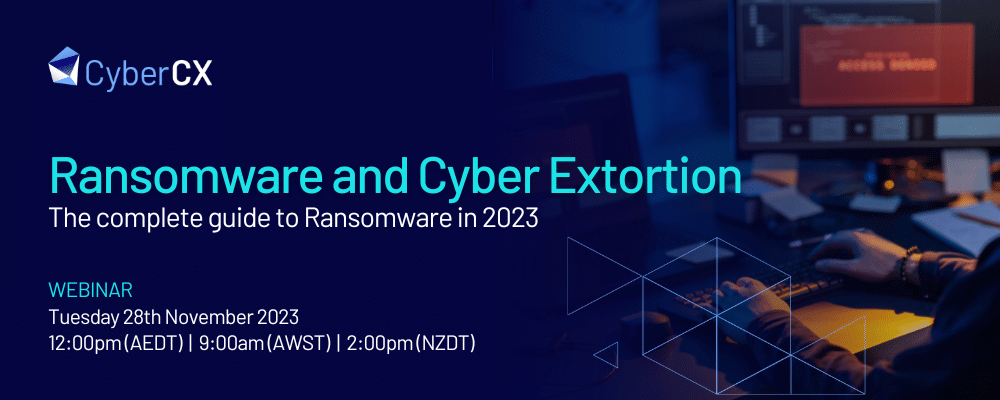Ransomware and Cyber Extortion
How to protect your organisation
This Best Practice Guide aligns CyberCX’s insights with recommendations to empower organisations to take practical steps to prevent, respond to, and recover from cyber extortion attacks.



CyberCX’s 2023 Ransomware and Cyber Extortion Best Practice Guide, reflects significant changes to the global cyber security landscape as businesses, organisations, and governments continue to grapple with established and emerging cyber threats.
The Guide leads with an up-to-date assessment of the cyber threat landscape and evolving threat actor tactics, which have significantly shifted in recent times, and highlights that:
- The impact and frequency of all forms of cyber extortion continue to increase. All organisations are at risk.
- Cyber criminals are experimenting with “harm maximisation” tactics to increase pressure on victim organisations to pay.
- There has been further fragmentation and diversification in the cyber extortion economy, driving specialisation, unpredictability, and more capable tradecraft.


Ransomware and Cyber Extortion
Best Practice Guide
Our Best Practice Guides offer clear, practical advice to improve organisations’ cyber security posture and resilience. We design these guides to be accessible for CEOs, boards, CISOs and professionals of all backgrounds.

Cyber extortion: State of play in 2023

Understanding and responding to an attack

Best practice security controls to mitigate risk of attack

When and why organisations should engage with their attacker

Should you pay a ransom or extortion demand?

Our Best Practice Guides leverage CyberCX’s significant operational and advisory experience, including:
- Experience from incidents responded to by our Digital Forensics & Incident Response (DFIR) practice across the Indo-Pacific and globally.
- CyberCX Intelligence, a unique Indo-Pacific intelligence capability which leverages global open and closed sources, creates unique first-party regional intelligence, and actively monitors dark web and criminal marketplace forums.
- Insights from our Cyber Strategic Communications team, which advises senior leaders in many of our region’s most high-profile incidents.
- Insights from CyberCX’s Security Testing & Assurance (STA) practice, the largest security testing capability in the region.
- Telemetry collected by our Managed Security Services (MSS) teams monitoring client networks across Australia, New Zealand and globally.
- Insights from our Strategy & Consulting (S&C) and Governance, Risk & Compliance (GRC) practices on cyber security strategies, investments and risk management, and how leading organisations protect their most critical assets.


“ We believe all organisations should have access to strategies and tools to uplift their cyber security and improve resilience.”
Alastair MacGibbon, Chief Strategy Officer, CyberCX



Download the Best Practice Guide



Recommended content
Ransomware and cyber extortion webinar
Join this webinar hosted by CyberCX’s Intelligence and Incident Response experts Katherine Mansted and Hamish Krebs to uncover the key security measures and controls your organisation should implement to prevent, respond to, and recover from ransomware and cyber extortion attacks.
Australia’s trusted
cyber security and cloud partner
Expertise at scale
More than 1,300 cyber security and cloud professionals delivering solutions to our customers.
Eyes on glass 24/7
Continuous monitoring of your network across our 9 advanced security operations centres globally.
Help when you need it
The region’s largest team of incident responders handle over 250 cyber breaches per year.
Assessing your needs
Industry-leading experts conduct more than 500 baseline security assessments per year.
Providing credible assurance
Our exceptional team of ethical hackers conducts over 3,000 penetration tests per year.
Training the next generation
The CyberCX Academy is training 500 cyber professionals over the next three years.

Cyber security services
End-to-end services covering every challenge throughout your cyber security and cloud journey.





